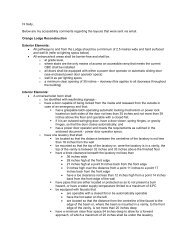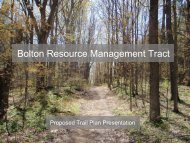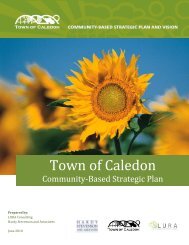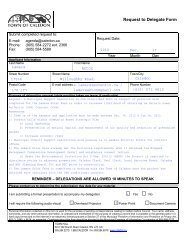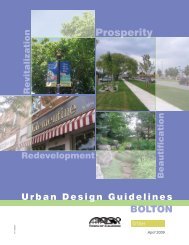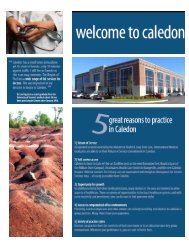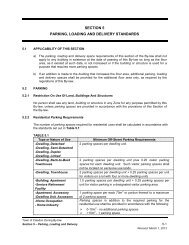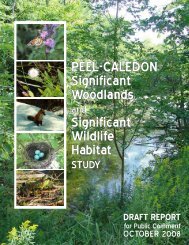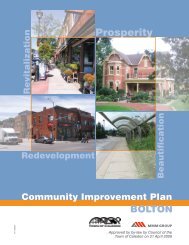Rockside Cultural Heritage Landscape Study - Town of Caledon
Rockside Cultural Heritage Landscape Study - Town of Caledon
Rockside Cultural Heritage Landscape Study - Town of Caledon
Create successful ePaper yourself
Turn your PDF publications into a flip-book with our unique Google optimized e-Paper software.
<strong>Rockside</strong> <strong>Cultural</strong> <strong>Heritage</strong> <strong>Landscape</strong> <strong>Study</strong><br />
<strong>Town</strong> <strong>of</strong> <strong>Caledon</strong><br />
• on the east side <strong>of</strong> Mississauga Road just south <strong>of</strong> Grange Road (Lot 5 W½<br />
Concession 4 WHS, shown as Jas. Kirkwood in 1877, and a later Patullo<br />
property);<br />
• on the west side <strong>of</strong> Shaw’s Creek Road, at the corner <strong>of</strong> Olde Base Line Road<br />
(Lot 1 E½ Concession 6 WHS, part <strong>of</strong> the original John MacDonald land holding,<br />
according to Crichton’s memoirs);<br />
• on the east side <strong>of</strong> Shaw’s Creek Road (Lot 2 W½ Concession 5 WHS, which is<br />
shown as Jas. MacDonald on the 1877 Atlas map); and<br />
• around the MacDonald cemetery (which is shown as owned by Daniel<br />
MacDonald on the 1877 Atlas map).<br />
Other early typical fence types in the<br />
area include stone pile fences<br />
(essentially out <strong>of</strong> stone rubble and<br />
not really laid) associated with land<br />
clearing, cedar rail fences (mostly<br />
rebuilt) and a combination where the<br />
stone ‘piles’ are surmounted with a<br />
cedar rail fence. Along Creditview<br />
Road the most prevalent fencing is<br />
the board fence associated with the<br />
horse farms. Each fence type imparts<br />
a particular visual rhythm to the<br />
landscape.<br />
Figures 5,6,7 illustrate the type and<br />
location <strong>of</strong> historic fences and<br />
fencerows found in the <strong>Rockside</strong> study area. Given that the documentation was<br />
undertaken through a windshield survey and air photo interpretation, it is not expected<br />
that this inventory is complete and there are likely many other fences internal to the<br />
properties shown, as well as others that may not have visible heritage components. The<br />
Rockfort farmstead, which was surveyed in detail through a previous study, is an<br />
example <strong>of</strong> how extensive the field fencing was on some <strong>of</strong> the properties (Refer to<br />
Figure 5. Source <strong>of</strong> detailed information on the Rockfort farmstead: <strong>Cultural</strong> <strong>Heritage</strong><br />
<strong>Landscape</strong> Assessment: Rockfort Quarry Site, Dillon Consulting Limited, October 1999).<br />
Settlement Clusters<br />
<strong>Rockside</strong> stone fence with cedar shims at the<br />
MacDonald family cemetery<br />
Nothing remains <strong>of</strong> the one node <strong>of</strong> settlement within the study area, that being the<br />
hamlet <strong>of</strong> <strong>Rockside</strong> itself. Shown on historic maps as including a smithy, store and Inn by<br />
1859, and a smithy, store and Temperance Hotel by 1877, it had clearly developed to<br />
serve this rather isolated area. However, with the advent <strong>of</strong> better roads and later the<br />
common use <strong>of</strong> the automobile, residents could readily travel to larger centers where a<br />
greater variety <strong>of</strong> products and services were available.<br />
27



